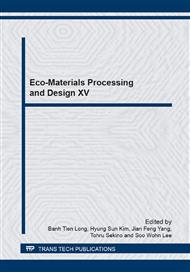p.127
p.131
p.135
p.139
p.145
p.149
p.153
p.157
p.161
Density Functional Theory Study of the Interaction of Nitric Oxide with 3D Transition Metal Dimers
Abstract:
Density-functional theory (DFT) has been used to calculate the interaction of nitric oxide with 3d metal dimers (scandium through zinc) and determine the ground-state geometrical configurations and vibrational frequencies. Results are compared to the relevant experimental values and to other theoretical investigations when available, and the overall agreement has been obtained. On going from left to right side of the Periodic Table, the preference for the coordination mode of NO to transition-metal dimers is from side-on-bonded mode (Sc, Ti, V), via semibridging (Cr), to end-on-bonded mode (Mn, Fe, Co, Ni, Cu). The N-O stretching vibrational frequencies in the ground states of M2NO (M = Sc to Zn) increase generally from the left to the right side of the Periodic Table, whereas the N-O bond lengths decrease generally. The binding energies exhibit an overall decrease trend. These general trends in the interaction of nitric oxide with 3d metal dimers mirror the main features of NO adsorption on transition metal surfaces.
Info:
Periodical:
Pages:
145-148
Citation:
Online since:
October 2014
Authors:
Price:
Сopyright:
© 2015 Trans Tech Publications Ltd. All Rights Reserved
Share:
Citation:


